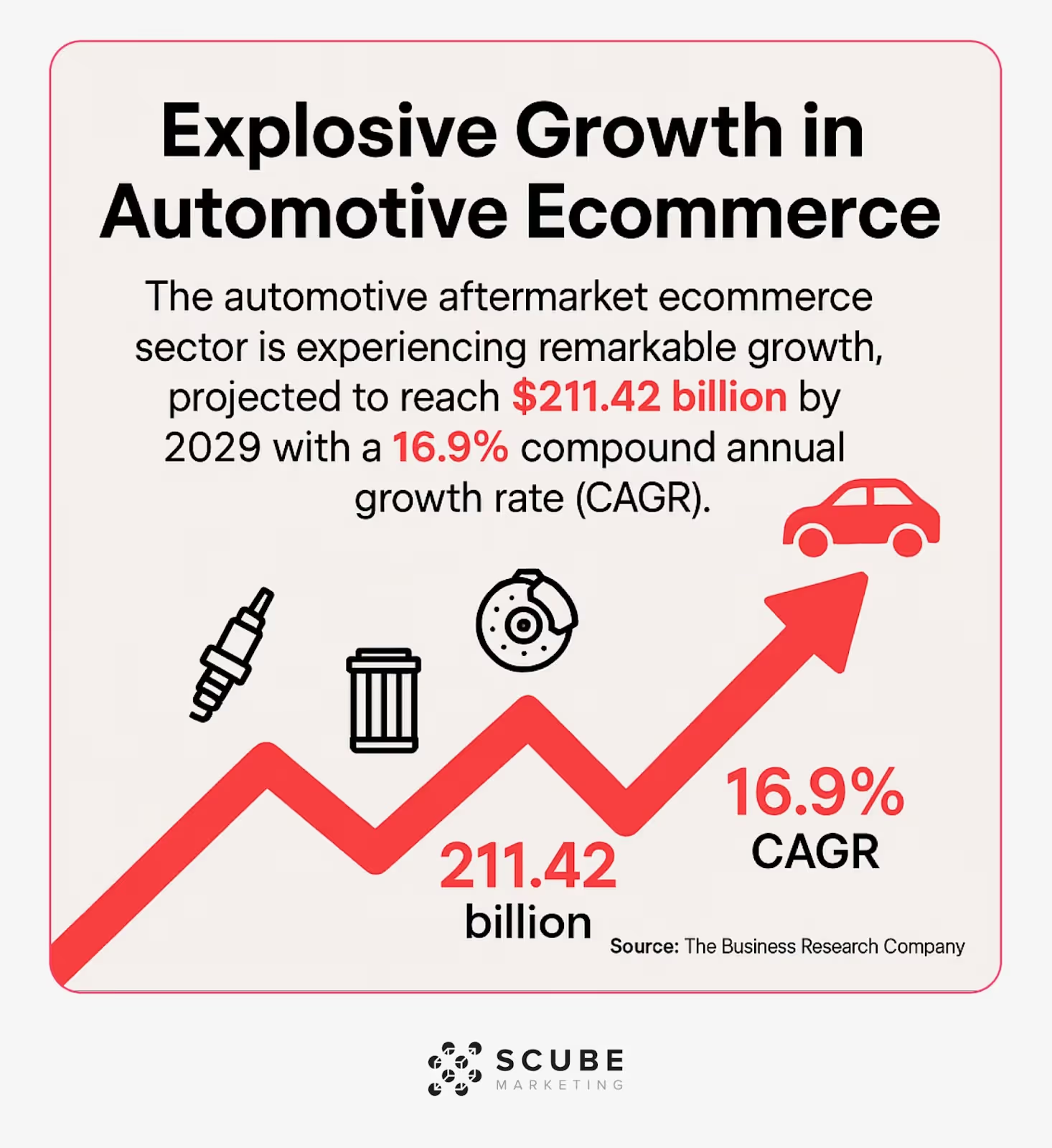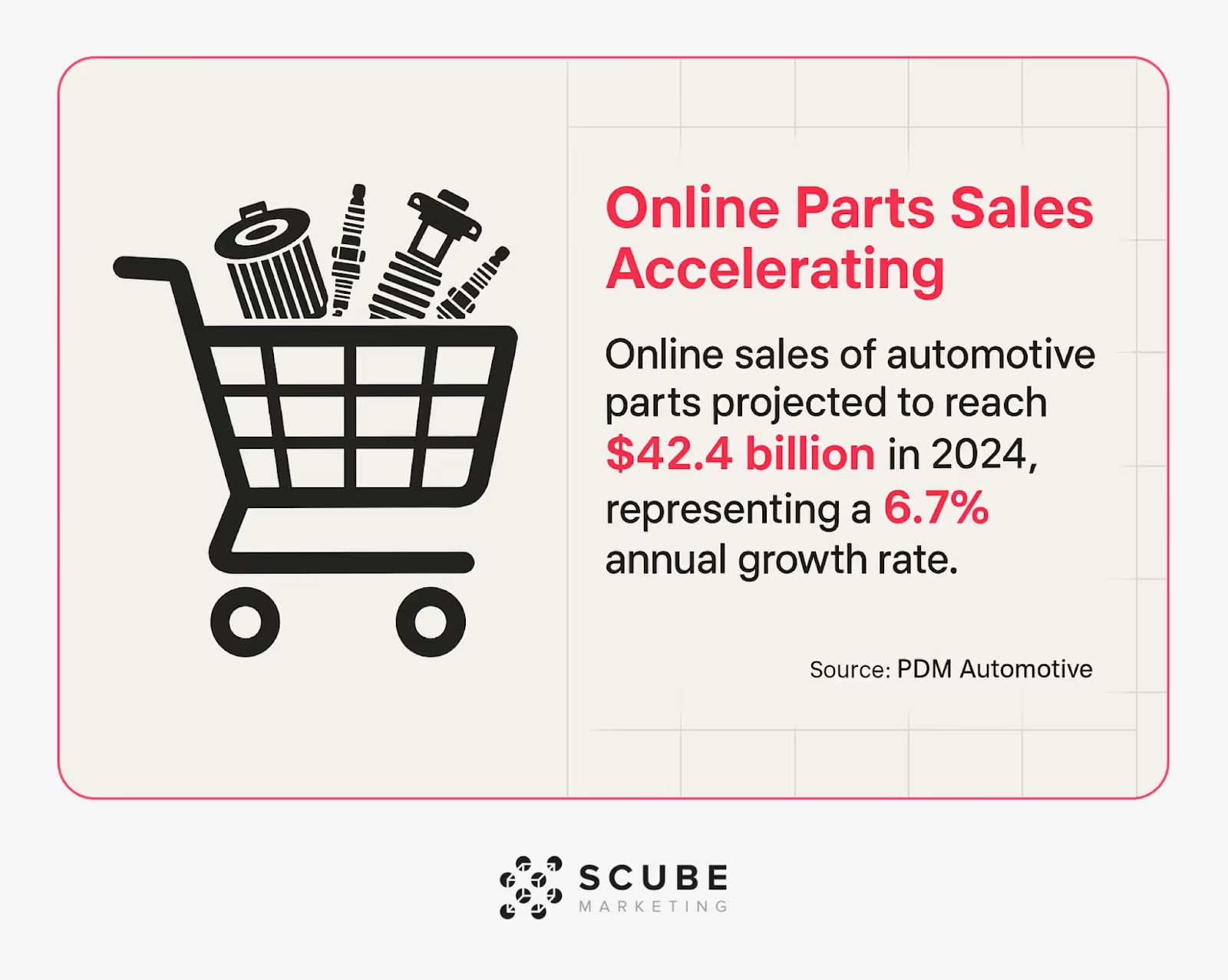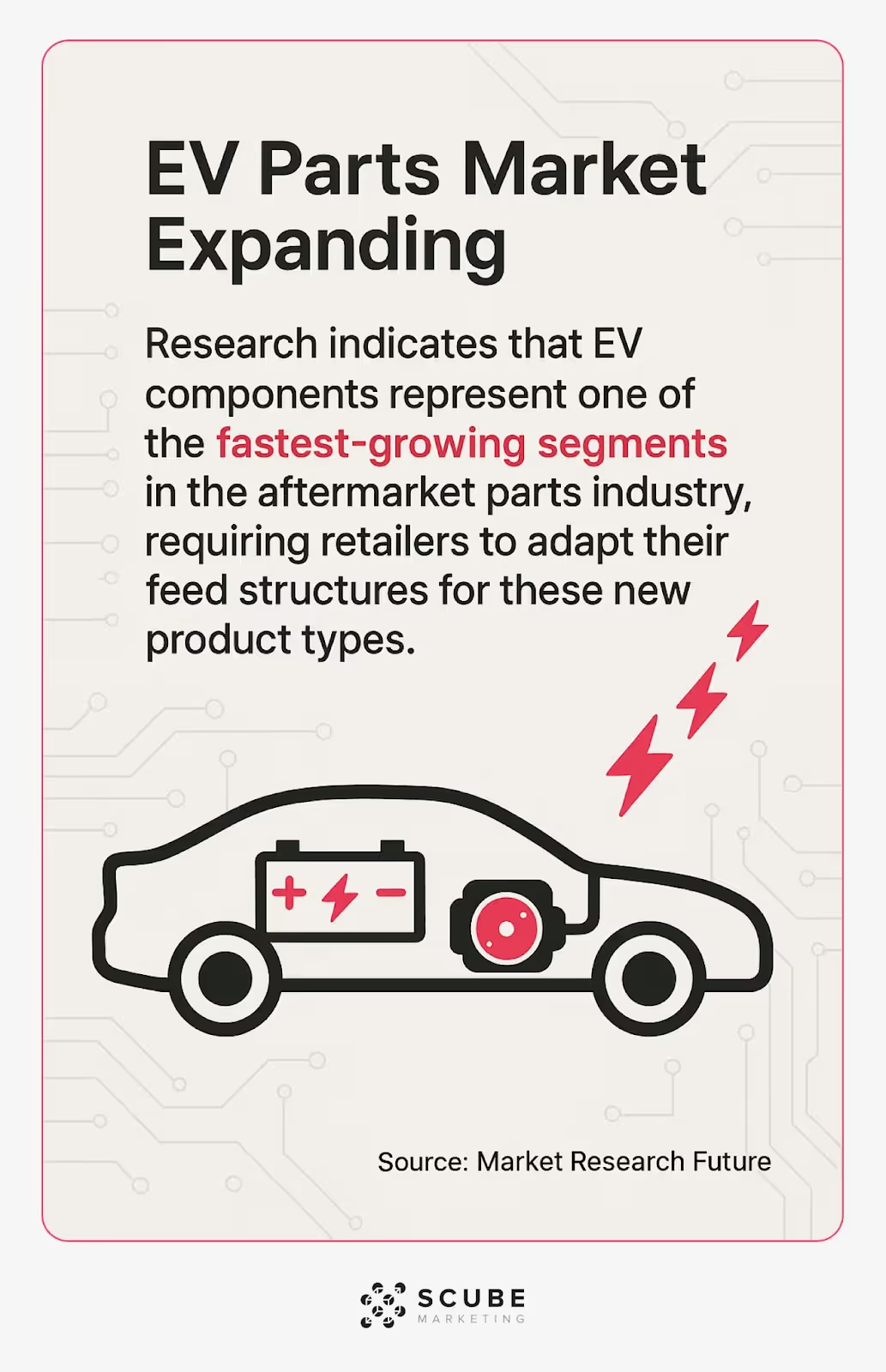
If you've ever managed an online automotive parts store, you know that getting your products in front of the right customers is about much more than just having quality parts. The backbone of your visibility across Google Shopping, Amazon, eBay Motors, and other platforms is something that rarely gets the spotlight: your product data feed.

The automotive aftermarket ecommerce sector is experiencing remarkable growth, projected to reach $211.42 billion by 2029 with a 16.9% compound annual growth rate (CAGR). (Source: The Business Research Company)
As someone who's worked with numerous automotive parts retailers to optimize their digital marketing, I've seen firsthand how a well-structured product data feed can be the difference between getting lost in the digital junkyard and driving significant sales growth.
In this comprehensive guide, I'll walk you through everything you need to know about creating, optimizing, and maintaining product data feeds specifically for automotive parts. We'll cover the essential components, optimization strategies, advanced techniques, and future trends that will help your automotive parts business thrive online.
A product data feed is essentially a file (typically CSV, XML, or JSON) containing all the information about your products that platforms like Google Merchant Center, Amazon, or eBay need to display your items correctly. For automotive parts, these feeds are particularly complex due to the nature of the products.
Unlike many other retail categories, automotive parts require extensive technical specifications, compatibility information, and fitment data to ensure customers find the right parts for their specific vehicles. This complexity makes feed optimization both challenging and critically important.

The market's growth underscores this importance, with online sales of automotive parts projected to reach $42.4 billion in 2024, representing a 6.7% annual growth rate. (Source: PDM Automotive)
For parts retailers, this growth represents enormous opportunity, but capturing market share requires technical precision in your product data. Poor data quality doesn't just reduce visibility—it actively drives away customers who receive irrelevant results or insufficient information to make purchasing decisions.
Auto parts feeds face several unique challenges. Each part must include compatibility information for potentially dozens or hundreds of vehicle makes, models, years, and trim levels. Technical specifications can include hundreds of attributes.
Parts may also have complex relationships with other components, replacement cycles, and installation requirements. All this information must be structured in a way that different platforms can interpret correctly.

The automotive market faces additional complexity due to rapid changes in vehicle technology. Research indicates that EV components represent one of the fastest-growing segments in the aftermarket parts industry, requiring retailers to adapt their feed structures for these new product types. (Source: Market Research Future)
This evolving market means your feed structure must be flexible enough to accommodate emerging part types while still maintaining compatibility with traditional vehicle components.
Creating an effective automotive parts data feed requires attention to both universal feed requirements and industry-specific attributes. Let's break down the essential components you need to include.
Beyond these basics, automotive parts require additional specialized attributes to maximize visibility and conversions. Let's examine the auto-specific fields that can make or break your feed performance.
The following attributes are essential for effective automotive parts listings:
When implemented correctly, these attributes ensure your parts appear in relevant searches when customers are looking for specific components for their vehicles. They also help reduce returns by setting clear expectations about compatibility.
Technical specifications play a crucial role in the decision-making process for automotive parts purchasers. According to automotive industry data, detailed technical specifications can increase conversion rates by making customers more confident in their purchase decisions.
Key technical specifications to include in your feed:
With the growing importance of sustainability in consumer purchasing decisions, including eco-certifications is becoming increasingly important. Research indicates that 72% of automotive parts buyers now filter by eco-certifications when making online purchases. (Source: EIN Presswire)
Now that we understand the key components of automotive parts feeds, let's dive into strategies to optimize these feeds for maximum visibility and conversion.
The title and description fields are crucial for search visibility across all platforms. For automotive parts, these fields need to balance search optimization with clear communication of compatibility and features.
Optimizing titles and descriptions is not just about including keywords—it's about structuring information in a way that both search algorithms and human shoppers can easily understand. The most effective listings follow consistent patterns that quickly communicate the most important details.
Proper category mapping ensures your parts appear in the right sections of marketplace and shopping platforms. Each platform has its own taxonomy, and mapping your products correctly requires understanding these structures.
For Google Shopping, you'll need to use Google's product taxonomy. For automotive parts, most items will fall under "Vehicles & Parts > Vehicle Parts & Accessories" followed by more specific subcategories.
Amazon uses its own classification system with ACES (Aftermarket Catalog Exchange Standard) and PIES (Product Information Exchange Standard) compatibility, requiring even more detailed categorization.
Incorrect category mapping is one of the most common reasons automotive parts get disapproved or perform poorly in shopping campaigns. Take the time to review each platform's latest category requirements and map your products accordingly.
For automotive parts, pricing and inventory management in your feed requires special attention due to the competitive nature of the market and the urgency of many purchases.
Best practices include:
The frequency of feed updates can significantly impact performance. For high-volume sellers, daily or even hourly updates may be necessary to maintain accurate inventory and pricing information.
Beyond the basics, there are several advanced techniques that can give your automotive parts feed a competitive edge. These strategies can help you target specific customer segments, improve campaign performance, and increase overall sales.
Fitment data—the information about which vehicles a part is compatible with—is perhaps the most complex aspect of automotive parts feeds. Mismanaged fitment data leads to incorrect compatibility information, resulting in returns, negative reviews, and wasted ad spend.
Advanced retailers are now implementing dynamic fitment data that adjusts based on inventory and customer behavior. This approach allows for more precise targeting and reduced wasted ad spend on incompatible applications.
Want to learn more about why MPN numbers are critical for automotive product listings? Our detailed guide explains how proper part number management affects both visibility and customer trust.
Custom labels provide a powerful way to segment your products for specific marketing strategies. In Google Merchant Center, you can use up to five custom labels (numbered 0-4) to create logical groupings.
Strategic custom label implementations for auto parts:
These custom labels enable sophisticated campaign structures that align with business goals rather than just product categories. For example, you might bid more aggressively on emergency repair parts during weekdays when shops are ordering, while reducing bids on weekend nights.
Mobile optimization for auto parts feeds has become essential in today's market. The strategies that work for desktop shoppers often fall short on mobile devices, where screen space is limited and users typically have different search behaviors.
For mobile optimization, focus on front-loading critical information in titles and descriptions. Use mobile-friendly images that show detail clearly even on small screens. Consider implementing location-based inventory that highlights parts available nearby for urgent repairs.
Streamline technical specifications to prioritize the most decision-critical information for mobile users. You might also consider creating separate feed variations optimized specifically for mobile platforms versus desktop to maximize performance across all devices.
Our research on automotive aftermarket consumer behavior reveals important insights about how mobile shoppers search for and purchase auto parts online.
Once your automotive parts feed is live, the work isn't done. Continuous measurement and optimization are essential for maintaining and improving performance over time.
Tracking the right metrics helps identify areas for improvement in your feed quality and structure.
Beyond these standard metrics, automotive parts retailers should also track fitment-specific performance indicators like "compatibility queries" (searches that include vehicle information) and "fitment abandonment" (when users leave after checking compatibility).
Even well-maintained feeds can develop problems over time. Here are common issues specific to automotive parts feeds and their solutions:
A systematic approach to feed issue resolution includes regular feed audits, competitive analysis, and platform-specific diagnostics. Most platforms provide error reports and optimization suggestions that should be reviewed regularly.
Strategic A/B testing can dramatically improve feed performance over time. For automotive parts, you should test different title formats to determine whether brand-first or part-type-first structures perform better. Compare conversion rates between listings with basic versus comprehensive technical specifications. Test professional product photos against in-vehicle installation images to see which drives more engagement. Experiment with "everyday low price" versus "sale pricing" structures to identify the most effective pricing presentation. Also try different ways of communicating vehicle fitment information to find the most user-friendly format.
When conducting tests, make sure to isolate variables and run tests long enough to gather statistically significant data. For most automotive parts categories, this means at least two weeks per test unless you have extremely high traffic volumes.
How can you master A/B testing for Google Ads to achieve maximum results from your feed optimization efforts? Our step-by-step guide shows you how to structure tests that deliver actionable insights.

The automotive aftermarket is evolving rapidly, and staying ahead of emerging trends is critical for long-term success. The e-commerce automotive aftermarket is expected to reach $113.3 billion by 2025, growing at a 17% CAGR from 2024. (Source: The Business Research Company)
Here are the key trends shaping the future of automotive parts data feeds:
The growth of electric vehicles is creating new categories and compatibility requirements for parts feeds. Online sales of electric and hybrid vehicle components are becoming a key growth driver in the automotive aftermarket.
Feed optimization for EV parts requires new compatibility parameters such as battery capacity, motor type, and charging system specifications. Different technical specifications like voltage ratings, energy efficiency metrics, and thermal management are becoming standard. Expanded categories for charging accessories, battery maintenance, and power management components are emerging. Additionally, specialized certifications for safety ratings on high-voltage components are increasingly important.
Retailers who adapt their feed structure to accommodate these new requirements will gain an early advantage in this growing segment.
With counterfeit parts being a significant concern in the industry, platforms are implementing stricter verification requirements and enhanced anti-counterfeit measures.
Preparing your feed for these enhanced verification requirements now will prevent approval issues as platforms continue to strengthen their anti-counterfeit measures.
The increasing global awareness of e-commerce channels for automotive parts creates new opportunities for cross-border selling. Expanding your market beyond domestic borders requires specific feed optimizations.
Optimizing your feed for international markets requires multi-language support with translated titles, descriptions, and technical specifications. You'll need to include regional compliance information to meet different regulatory standards by market. International fitment data must account for vehicle models and naming conventions that vary by region. Dynamic pricing based on exchange rates and regional competition is essential for competitiveness. Clear information on international shipping options and import duties helps set proper customer expectations.
Implementing these enhancements will position your store to capture the growing international demand for automotive parts online.

Optimizing your automotive parts data feed is not a one-time task but an ongoing process that requires attention to detail, technical knowledge, and strategic thinking. As we've explored throughout this guide, effective feed management combines industry-specific requirements with platform best practices and emerging trends.
The key takeaways for automotive parts retailers:
By implementing these strategies, you'll be well-positioned to capture your share of the rapidly growing automotive aftermarket e-commerce sector. If you're looking for more comprehensive guidance, our complete guide to selling auto parts online provides additional insights into the entire ecommerce ecosystem for automotive retailers.
Remember that in the competitive world of online automotive parts sales, your product data feed isn't just a technical requirement—it's a strategic asset that can drive significant growth when properly optimized.